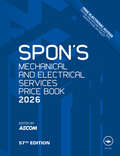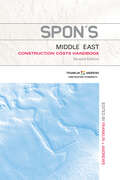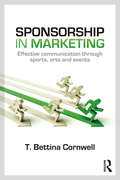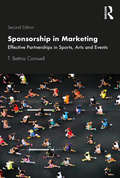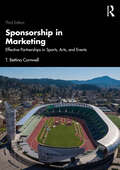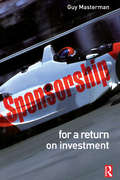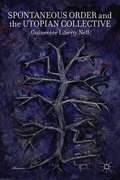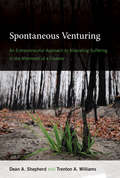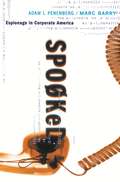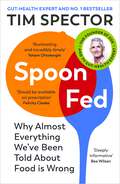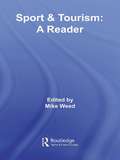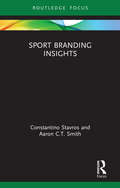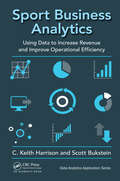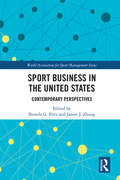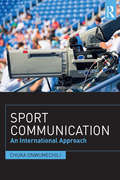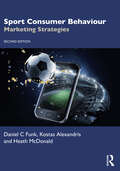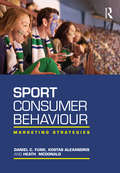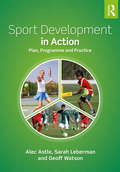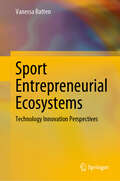- Table View
- List View
Spon's Mechanical and Electrical Services Price Book 2026 (Spon's Price Books)
Compiled by AECOM, the 2026 edition has been updated with the latest pricing information to help you manage your projects over the next 12 months through this challenging period of inflationary pressure, global uncertainty and skills shortages.It covers the full range of mechanical and electrical services, together with higher-level costs for a diverse range of systems and different building applications. All prices have been updated via comprehensive supplier engagement combined with AECOM’s market intelligence and a short-term inflationary forecast to ensure you have the most accurate cost data available. The approximate estimating section has been revised to provide up-to-date key data in terms of square metre rates, all-in-rates for key elements and selected specialist activities and elemental analyses on a comprehensive range of building types.All the standard features you have come to expect from SPON'S MECHANICAL AND ELECTRICAL SERVICES PRICE BOOK are also included, considered essential for today’s services cost professional: detailed materials prices, labour constants, labour costs and measured work prices for mechanical and electrical works, from above ground drainage to automatic transfer switches, and circuit breakers to sprinkler systems an extensive Approximate Estimating section for quick, rule-of-thumb pricing of mechanical or electrical installations, together with elemental services costs for different types and standard of buildings full details of wage rates, daywork and cost indices on a national and Central London basis an updated index and guidance notes Included within the inside front cover of every book is a VitalSource® eBook redemption code giving one user access to the content digitally until the end of December 2026.
Spon's Middle East Construction Costs Handbook (Spon's International Price Books)
by FranklinThe indispensable guide to building costs in Bahrain, Egypt, Iran, Iraq, Jordan, Kuwait, Lebanon, Libya, Oman, Qatar, Saudi Arabia, Syria and the UAE. Features detailed information across all sectors and by individual country, plus comparative information.
Sponsorship in Marketing: Effective Communication through Sports, Arts and Events
by T. Bettina CornwellSponsorship of sports, arts or events can be a powerful form of marketing communication for businesses and organizations. This book introduces the fundamentals of sponsorship-linked marketing, helping the reader to understand how sponsorship can be planned, executed and measured. Drawing on original research, and exploring key theory, best practice and cutting-edge issues, this is also the only book to fully explain how the sponsor can implement successful sponsorship campaigns and achieve their communication objectives. The book covers every important conceptual and functional area of sponsorship in marketing communications, including: audiences, strategies and objectives leveraging and activation building sponsorship portfolios measurement and evaluation ambush marketing managing relationships internal audiences public policy and legal issues Every chapter includes case studies, examples and data from real organizations, business, campaigns and events, vividly illustrating the link between fundamental principles and effective practice. No other book provides such a comprehensive, evidence-based introduction to sponsorship, demonstrating how organizations can connect brands to real life. This is essential reading for all students and practitioners working in sport marketing, sport business, events marketing, arts administration, business communication or marketing management.
Sponsorship in Marketing: Effective Partnerships in Sports, Arts and Events
by T Bettina CornwellSponsorship of sports, arts or events can be a powerful form of marketing communication for businesses and organizations. This new edition of Sponsorship in Marketing introduces the fundamentals of sponsorship-linked marketing, helping the reader to understand how sponsorship can be planned, executed and measured. Drawing on original research, and exploring key theory, best practice and cutting-edge issues, the book fully explains how the sponsor can implement successful sponsorship to achieve communication and engagement objectives. It covers every important conceptual and functional area of sponsorship in marketing communications, including: understanding the technology-led transformation of sponsoring audiences, strategies and objectives leveraging and activation in traditional and social media building sponsorship portfolios and rosters managing and ending relationships public policy and legal issues Every chapter includes international case studies and examples, test questions, and data from real organizations, business, campaigns and events, vividly illustrating the link between fundamental principles and effective practice. This updated edition features a new model of the sponsorship process with an ecosystem perspective, discussion of endorsers and influencers in sponsorship, an introduction to the impact of streaming on sponsoring, and entirely new thinking on sponsorship returns and evaluation. No other book provides such a comprehensive, evidence-based introduction to sponsorship, demonstrating how organizations can connect brands to real life. This is essential reading for all students and practitioners working in sport marketing, sport business, events marketing, arts administration, business communication or marketing management.
Sponsorship in Marketing: Effective Partnerships in Sports, Arts, and Events
by T. Bettina CornwellNow in a fully revised and updated third edition, Sponsorship in Marketing introduces the fundamentals of sponsorship-linked marketing, helping the reader to understand how sponsorship can be planned, executed, and measured.Drawing on original research and exploring key theory, best practice, and cutting-edge issues, this book fully explains how to implement successful partnerships to achieve branding, communication, and engagement objectives. It covers every important conceptual and functional area of sponsorship in marketing communications, including the technology-led transformation of sponsorship, audiences, strategies and objectives, leveraging and activation in traditional and social media, building sponsorship portfolios and rosters, managing and ending relationships, and public policy and legal issues. Every chapter includes international case studies and examples, self-test questions, and examples from real organizations, businesses, campaigns, and events, vividly illustrating the link between fundamental principles and effective practice. This updated edition includes expanded coverage of technology, including digital assets and data; influencers, including name and image likeness (NIL); contracts and “deliverables;” and ethical issues including sportswashing. No other book provides such a comprehensive, evidence-based introduction to sponsorship, demonstrating how organizations can connect brands to real life.This is an essential textbook for any course on sponsorship, and invaluable reading for any practitioner working in sport marketing, sport business, events marketing, arts administration, business communication, or marketing management.Additional resources for instructors include slides, videos highlighting concepts, and additional case problems.
Sponsorship: For a Return on Investment
by Guy MastermanSponsorship is both a critical communications tool for sponsors as well as a fundamental revenue stream for rights owners. Market leaders use sponsorship widely and arguably more successfully than any other communications tool to achieve competitive advantage whilst events of all sizes depend on sponsorship just to exist. As the importance of sponsorship has increased the demands of it have risen too. Now sponsors seek measurable return on their investment. Sponsorship: For a Return on Investment provides a unique insight on the use of sponsorship for a return on investment and will appeal to practitioners and undergraduate and postgraduate students alike. It builds a conceptual framework for the development, planning, implementation and evaluation of strategies for sport, arts, music and community sponsorship, and from two perspectives: For rights owners, the importance of effectively acquiring and then developing a bespoke approach for the recruitment of sponsors for effective sponsorship programmes. For sponsors, a better understanding of how sponsorship can be used for successful integrated marketing communications. A broad selection of examples and case studies from around the world are provided in order to demonstrate the importance of sponsorship on an international basis. This book is vital resource for both students and practioners.
Spontaneous Order and the Utopian Collective
by Guinevere Liberty NellVladimir Lenin, Leon Trotsky, and Nikolai Bukharin were the three leaders of the Russian Revolution who shaped the new society most, both through their theories and their political leadership. All three were motivated by the ideal of building a utopian collective. Once in power, they tirelessly tried to put their vision into practice, but the Soviet system that resulted was nothing like the one they tried to create. In Spontaneous Order and the Utopian Collective, Nell takes her cue from the personal writings and documents of Lenin, Trotsky, and Bukharin to consider them anew from an Austrian theoretical perspective, analyze the divergence between theory and practice using a spontaneous order framework, and identify three interconnected prerequisites necessary for a utopian collectivist society. Nell then asks whether it might be possible to create this utopian collective somehow, and avoid the pitfalls of planning.
Spontaneous Venturing: An Entrepreneurial Approach to Alleviating Suffering in the Aftermath of a Disaster (The\mit Press Ser.)
by Dean A. Shepherd Trenton A. WilliamsIdentifying a new approach to disaster response: spontaneous, compassionate, and impromptu actions to alleviate suffering.In Spontaneous Venturing, Dean Shepherd and Trenton Williams identify and describe a new approach for responding to disaster and suffering: the local organizing of spontaneous, compassionate, and impromptu actions—the rapid emergence of a compassionate venture. This approach, termed by the authors “spontaneous venturing,” can be more effective than the traditional “command-and-control” methods of large disaster relief organizations. It can customize and target resources and deliver them quickly, helping victims almost immediately. For example, during the catastrophic 2009 bushfires in Victoria, Australia—the focal disaster for the book—residents organized an impromptu relief center that collected and distributed urgently needed goods without red tape. Special bonds and friendships formed among the volunteers and victims; some were both volunteer and victim. Many victims were able to mobilize resources despite considerable personal losses.Shepherd and Williams describe the lasting impact of disaster and tell the stories of Victoria residents who organized in the aftermath of the bushfires. They consider the limitations of traditional disaster relief efforts and explain that when victims take action to help others, they develop behavioral, emotional, and assumptive resilience; venturing leads to social interaction, community connections, and other positive outcomes. Finally, they explore spontaneous venturing in a less-developed country, investigating the activities of Haitians after the devastating 2010 earthquake. The lesson for communities hit by disaster: find opportunities for compassionate action.
Spooked: Espionage In Corporate America
by Adam L. PenenbergImagine your main business competitor building a satellite-equipped "war room" to secretly monitor your new ventures. Imagine your classified product prototype mysteriously landing on the market under the brand name belonging to your archrival. Impossible? This isn't a story line from the latest spy thriller, it's modern-day corporate America. Spooked thrusts readers into a clandestine world-where business means war and information is worth stealing. Through narrative accounts of corporate spies within companies such as IBM, Microsoft, and Motorola, Spooked dramatically brings to life one of America's fastest-growing industries: Corporate Intelligence. In this page-burning exposé, Adam Penenberg and Marc Barry uncover and describe in thrilling detail the alarming regularity of espionage in industry. They offer an unsettling portrait of America's publicly traded companies, and unravel the truth and hypocrisy behind the multi-billion dollar corporate intelligence industry.
Spoon-Fed: Why almost everything we’ve been told about food is wrong, by the #1 bestselling author of Food for Life
by Tim SpectorTHE #1 SUNDAY TIMES BESTSELLER FROM THE LEADING GUT-HEALTH EXPERT, FOUNDER OF ZOE AND AUTHOR OF FOOD FOR LIFE* As seen on ITV's LORRAINE and heard on THE DIARY OF A CEO *This ground-breaking exploration debunks food myths, from what we should be eating for breakfast to whether we should really avoid ultra-processed foods.Is breakfast really the most important meal of the day?Is there any point in counting calories?Is there any evidence that coffee is bad for us?Through his pioneering research, Professor Tim Spector busts these and many other myths about food.Spoon-Fed explores the scandalous lack of good science behind many diet plans, official recommendations, miracle cures and ultra-processed foods, and encourages us to rethink our whole relationship with food - not just for our health as individuals, but for the future of the planet.'Hugely enjoyable' Michael Mosley'Illuminating and so incredibly timely' Yotam Ottolenghi'This book should be available on prescription' Felicity Cloake'Will actually help you decide what to add to your next grocery shop' Bee Wilson, GuardianGo with your gut. Join the food revolution.**Tim Spector's number 1 bestselling Food for Life: Your Guide to the New Science of Eating Well is now available in paperback****PRE-ORDER THE FOOD FOR LIFE COOKBOOK, COMING OCTOBER 2024, NOW**
Sport & Tourism: A Reader
by Mike WeedThis Reader provides comprehensive coverage of the scholarly literature in sports tourism. Divided into four parts, each prefaced by a substantial introduction from the editor, it presents the key themes, state of the art research and new conceptual thinking in sports tourism studies. Topics covered include: understanding the sports tourist impacts of sports tourism policy and management considerations for sports tourism approaches to research in sports tourism Articles cover a broad range of the new research that has a bearing on sports tourism and include diverse areas such as the economic analysis of sports events, sub-cultures in sports tourism, adventure tourism and tourism policy.
Sport Analytics: A data-driven approach to sport business and management
by Gil Fried and Ceyda MumcuThe increasing availability of data has transformed the way sports are played, promoted and managed. This is the first textbook to explain how the big data revolution is having a profound influence across the sport industry, demonstrating how sport managers and business professionals can use analytical techniques to improve their professional practice. While other sports analytics books have focused on player performance data, this book shows how analytics can be applied to every functional area of sport business, from marketing and event management to finance and legal services. Drawing on research that spans the entire sport industry, it explains how data is influencing the most important decisions, from ticket sales and human resources to risk management and facility operations. Each chapter contains real world examples, industry profiles and extended case studies which are complimented by a companion website full of useful learning resources. Sport Analytics: A data-driven approach to sport business and management is an essential text for all sport management students and an invaluable reference for any sport management professional involved in operational research.
Sport Branding Insights (Sport Business Insights)
by Constantino Stavros Aaron C.T. SmithIn a sporting world dominated by media and money, an understanding of sport branding is an essential skill for any sport manager. Success means being able to ‘brand’ – and therefore differentiate – a sport club, player, code, or event in a highly competitive entertainment market. For anyone seeking to understand or manage sport, this book offers an immediate and salient insight into the complex and dynamic process of creating a powerful sport brand. The book explains how a sport brand goes beyond just an identifying badge, reinforced by a name or a logo that helps sport consumers recognise a product or an organisation. It reveals how a brand becomes linked with consumers’ opinions and perceptions of a sport product and the organisation that owns it. Readers will learn how to create a powerful brand that has both recognition in the market and strong associated imagery, by imbuing it with a spirit of the past through appeals to tradition, by endowing it with human qualities of emotionality, thought, and volition, and through the use of characters, colours, texts, and symbols. It also provides a brief guide to the new domains of digital sport branding and social media. Concise, informative, and entertaining, this is an essential resource for anyone exploring or practising the business of sport.
Sport Brands
by Patrick Bouchet Dieter Hillairet Guillaume BodetSport brands are a central element of modern sport business and a ubiquitous component of contemporary global culture. This groundbreaking book offers a complete analysis of the topic of sport brands from both a marketing management approach (strategy and implementation) and a psycho-sociological approach (consumption and wider society). In doing so it explores both supply and demand sides, offering a complete introduction to the nature, purpose and value of sport brands not found in any other sports marketing text. The book covers the whole heterogeneity of sport brands, going much further than the sport team and league brands covered in most other books. As well as teams and leagues, the book considers the brands of sports celebrities, events, media, computer games and governing bodies, as well as the ethical, professional and technological ‘label brands’ associated with sport. Richly illustrated with cases, examples and data, the book explores the tangible and intangible influence of sport brands, their economic and social value, and the subcultures and communities that grow up around them. It also introduces common strategies for growing brands, and growing through brands, and examines the challenges and threats that sport brands face, from boycotts and ambush marketing to counterfeiting. An understanding of sport brands is essential for a fully rounded understanding of contemporary sport marketing. As a result, this book is important reading for any student or practitioner working in sport marketing, sport business, or mainstream marketing management.
Sport Broadcasting for Managers
by Stephen Frawley Hunter FujakThis is the first book to focus on sport broadcasting as a core aspect of contemporary sport business and management. It explains how sport business professionals can manage sport broadcasting as an essential component of their work. Drawing on cutting-edge theory and research into sport broadcasting around the world, the book introduces the history and core concepts of sport broadcasting, before showing how broadcasting intersects with sport management practice. It covers key themes and issues such as the law and regulation, valuation and negotiation, strategy, logistics and consumer behaviour. Outlining best practice for sport managers, this book is essential reading for any course on sport business and management, sport marketing or sport media, and a useful companion to courses on broadcast production, sports journalism or digital media.
Sport Business Analytics: Using Data to Increase Revenue and Improve Operational Efficiency (Data Analytics Applications)
by Scott Bukstein C. HarrisonDeveloping and implementing a systematic analytics strategy can result in a sustainable competitive advantage within the sport business industry. This timely and relevant book provides practical strategies to collect data and then convert that data into meaningful, value-added information and actionable insights. Its primary objective is to help sport business organizations utilize data-driven decision-making to generate optimal revenue from such areas as ticket sales and corporate partnerships. To that end, the book includes in-depth case studies from such leading sports organizations as the Orlando Magic, Tampa Bay Buccaneers, Duke University, and the Aspire Group. The core purpose of sport business analytics is to convert raw data into information that enables sport business professionals to make strategic business decisions that result in improved company financial performance and a measurable and sustainable competitive advantage. Readers will learn about the role of big data and analytics in: Ticket pricing Season ticket member retention Fan engagement Sponsorship valuation Customer relationship management Digital marketing Market research Data visualization. This book examines changes in the ticketing marketplace and spotlights innovative ticketing strategies used in various sport organizations. It shows how to engage fans with social media and digital analytics, presents techniques to analyze engagement and marketing strategies, and explains how to utilize analytics to leverage fan engagement to enhance revenue for sport organizations. Filled with insightful case studies, this book benefits both sports business professionals and students. The concluding chapter on teaching sport analytics further enhances its value to academics.
Sport Business in the United States: Contemporary Perspectives (World Association for Sport Management Series)
by Brenda G. Pitts; James J. ZhangSport is big business in the USA. From collegiate sport through to the professional leagues, the sport industry generates huge revenues, employs thousands of people and engages millions of fans and consumers. This book offers an evidence-based snapshot of the contemporary sport industry in the USA. Featuring new research from scholars working across every sector of sport business, the book covers key topics such as consumer behaviour, sport marketing, the development of women&’s sport, sport broadcasting, internships, and leadership. It adds critical depth to our understanding of the sport industry in the world&’s single biggest sport marketplace. Sport Business in the United States offers fascinating new perspectives for researchers, students and industry professionals. It is important reading for anybody working in sport management or sport business, whether inside the US or around the world.
Sport Communication: An International Approach
by Chuka OnwumechiliSport is a global business. Now more than ever, sport communication professionals need to understand sport’s global reach in order to develop their full potential. This is the first textbook to introduce the fundamental principles and practice of sport communication from an international perspective. Combining business strategies with insights into social issues such as gender, disability and national identity, this is an accessible, practical and engaging guide to the essentials of sport communication. Aimed to enhance learning at both undergraduate and postgraduate levels, each chapter contains special features tailored to meet the needs of students and instructors. These include learning objectives, chapter summaries, activities, reflections, discussion questions, recommended resource lists and original cross-cultural case studies that demonstrate sport communication theories put into practice. Its twenty chapters explore communication in sport across all levels, from interpersonal communication and team building to strategic communications, and in all forms of media, from print and broadcast to social media. Sport Communication: An International Approach is an essential text for any course on sport communication, sport business or sport management.
Sport Consumer Behaviour: Marketing Strategies
by Kostas Alexandris Heath McDonald Daniel C FunkNow in a fully revised and updated second edition, this textbook offers a complete introduction to consumer behaviour in sport and recreation. Combining theory and cutting-edge research with practical guidance and advice, it helps students and industry professionals become more effective practitioners. Written by three of the world’s leading sports marketing academics, the book covers all the key topics in consumer behaviour, including: • user experience and service design • segmenting consumer markets, building profiles, and branding • decision-making and psychological consequences • consumer motivation, constraints, and personalities • service quality and customer satisfaction • sociocultural and technological advancements influencing consumption This updated edition includes expanded coverage of key emerging topics such as technology (from streaming apps to wearables), e-sports and gamification, consumer research, brand architecture, consumer decision making, and fan attitudes. Including international examples throughout, it helps the reader to understand customer motivation and how that drives consumption and how design-relevant factors influence user experiences and can be used to develop more effective marketing solutions. This book is an invaluable resource for anyone involved in the sport, recreation, and events industries, from students and academics to professional managers. An accompanying eResource provides quizzes exclusively for instructors to assist student learning.
Sport Consumer Behaviour: Marketing Strategies
by Kostas Alexandris Heath McDonald Daniel C. FunkAll successful marketing strategies in sport or events must take into account the complex behaviour of consumers. This book offers a complete introduction to consumer behaviour in sport and events, combining theory and cutting-edge research with practical guidance and advice to enable students and industry professionals to become more effective practitioners. Written by three of the world’s leading sports marketing academics, it covers a wide range of areas including: social media and digital marketing the segmentation of the sport consumer market service quality and customer satisfaction sport consumer personalities and attitudes the external and environmental factors that influence sport consumer behaviour. These chapters are followed by a selection of international case studies on topics such as female sport fans, college sports, marathons and community engagement. The book’s companion website also provides additional resources exclusively for instructors and students, including test banks, slides and useful web links. As the only up-to-date textbook to focus on consumer behaviour in sport and events, Sport Consumer Behaviour: Marketing Strategies offers a truly global perspective on this rapidly-growing subject. This book is an invaluable resource for anyone involved in the sport and events industries, from students and academics to professional marketers.
Sport Development in Action: Plan, Programme and Practice
by Geoff Watson Alec Astle Sarah LebermanThis practical textbook explains the sport development process from a practitioner’s viewpoint, showing what actually works, how, and why. Focusing on the development of sport, the book considers the efforts of sport organisations to revitalise their sports at a community level to ensure their future relevance, growth, and sustainability. Full of real-world cases and data, as well as the voices and reflections of a wide range of practitioners, Sport Development in Action explains how to research and draw up a development plan, how to design and implement programmes and establish delivery networks, and how to monitor and evaluate initiatives. This is essential reading for any sport development course, and useful reading for courses in sport management, sports coaching, or sports studies. It is also an indispensable reference book for practitioners.
Sport Development in the United States: High Performance and Mass Participation (Routledge Research in Sport, Culture and Society)
by Peter Smolianov Dwight Zakus Joseph GalloThe development of both elite, high performance sport and mass participation, grassroots-level sport are central concerns for governments and sports governing bodies. This important new study is the first to closely examine the challenges and opportunities for sports development in the United States, a global sporting giant with a unique, market-driven sporting landscape. Presenting an innovative model of integrated sports development, the book explores the inter-relationship between elite and mass sport across history, drawing on comparative international examples from Australia to the former USSR and Eastern bloc countries. At the heart of the book is an in-depth empirical study of three (traditional and emerging) sports in the US – tennis, soccer and rugby – that offer important lessons on the development of elite sport, methods for increasing participation, and the establishment of new sports in new markets. No other book has attempted to model sports development in the United States in such depth before. Therefore this should be essential reading for all students, researchers, administrators or policy-makers with an interest in sports development, sports management, sports policy, or comparative, international sport studies.
Sport Development: Policy, Process and Practice, third edition (Sport For Sport: Theoretical And Practical Insights Into Sports Development Ser.)
by Kevin HyltonAt a time of profound change in the economic, social, political and sporting landscape, sport development faces important challenges. Now in a fully revised and updated third edition, Sport Development: Policy, Process and Practice is still the most detailed, authoritative and comprehensive guide to all aspects of contemporary sport development. This book examines the roles of those working in and around sport development and explores the most effective methods by which professionals and volunteers can promote interest, participation or performance in sport. Combining essential theory with practical analysis, the book covers key topics, themes and issues found on the sport development curriculum, including: Sport policy Developing ‘Sport for All’ Community sport development Partnerships in sport PE and school sport Sport and health Resources for developing sport Voluntary sports clubs Sport development and coaching Disability and sport development Researching and evaluating sport development The Olympic and Paralympic Games International sport and development Each chapter contains a full range of pedagogical features to aid learning and understanding, including revision questions, and case studies, while a new companion website provides additional teaching and learning resources, including useful weblinks for students and PowerPoint slides and a test bank for lecturers. Sport Development: Policy, Process and Practice is an invaluable resource for all students, researchers and professionals working in sport development.
Sport Entrepreneurial Ecosystems: Technology Innovation Perspectives
by Vanessa RattenThis book explores how the sport industry can be considered as an ecosystem due to the variety of different factors interacting to provide value to society. This book focuses on sport ecosystems as a way to understand technological developments such as the digitalization trend. By doing so, it focuses on the interlinkages between different entities in a sport context including profit and non-profit entities. This book takes a new and innovative perspective to how sport is conducted. This book will be among the first to specifically focus on the ecosystem environment as a way of understanding the flexibility and adaptability of those involved in sport.
Sport Entrepreneurship
by Vanessa RattenThis book introduces the structure, economic arguments, and business strategies for entrepreneurship in sport. Here, the entrepreneurial process is usually initiated by organizations, people or governments who are embedded in both economic and social contexts. The development of technologies that have enhanced the diffusion of information and the creation of new international markets has impacted sports entrepreneurship activities. The goal of this book is to introduce readers to emerging issues in sport entrepreneurship and management. The book focuses on the role of entrepreneurship in the sports context by examining how to leverage the opportunities that arise from networks and optimize resources by identifying where they can most effectively be put to use. As a unique discipline, sport entrepreneurship helps to identify the conditions under which and the processes in which upcoming business ventures need to be pursued. The book will be useful for sports organizations, athletes and government organizations promoting the use of entrepreneurship to generate competitive advantages on the global marketplace.
